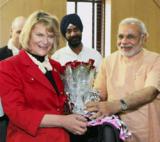 Chicago, Mar 30: Organisers of a US delegation to India who met Gujarat Chief Minister Narendra Modi had canvassed for participants in the trip at prices ranging from $3,000 to $16,000, said a media report.
Chicago, Mar 30: Organisers of a US delegation to India who met Gujarat Chief Minister Narendra Modi had canvassed for participants in the trip at prices ranging from $3,000 to $16,000, said a media report.The business delegation includes four US members of the House of Representatives, all Republicans.
The organisers had canvassed in the Indian American community for participants in the trip, according to a report published in Hi India, a South Asian newspaper from Chicago.
The trip was sponsored by a political action committee (PAC), the National Indian American Public Policy Institute (NIAPPI) founded by Shalabh Kumar, a Chicago businessman. The politicians leading the delegation are Marlin Stutzman, Cyntia Wiederspahn, Cathy Rodgers and Aaron Schock.
An invitation circulated by NIAPPI in preparation for the trip said it was “limited to (an) elite group of American businesspersons”.
The group has already met Narendra Modi in Ahmedabad and invited him to visit the US. On the schedule of an extensive trip is a stay at the Lake Palace in Udaipur, a visit to Karnataka as guest of the state government, a visit to the Taj Mahal, the tiger reserve at Ranthambore, a night at the Rambagh Palace in Jaipur, a visit to the Golden Temple in Amritsar and a dinner hosted by Punjab Chief Minister Parkash Singh Badal.
The cost options given in the invitation were: “Seven star trip” (business class travel, private air charter in India) $16,000 per person, “four star trip” (commercial travel in India with visits to the palace excluded) $10,000 per person, and economy option-with all travel and hotel expenses borne by the individual- $3,000 per person.
There also appears to be a controversy about the political action committees under which Kumar operates, according to the newspaper that is widely read in the South Asian community in the US Midwest.
In 2012, it reported, he ran advertisements attacking Democrat Tammy Duckworth, a respected military veteran who lost both her legs in the Iraq war.





Comments
Add new comment